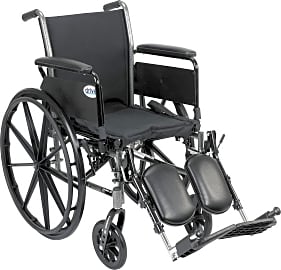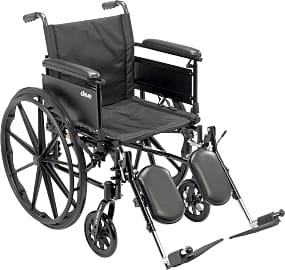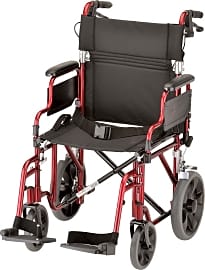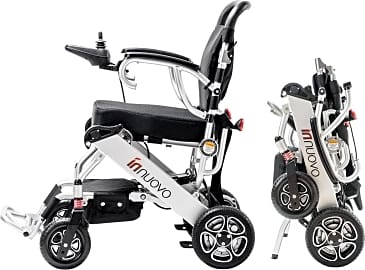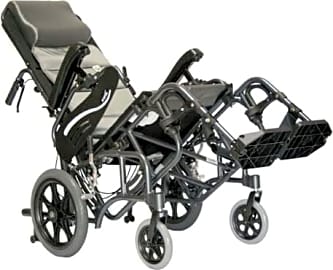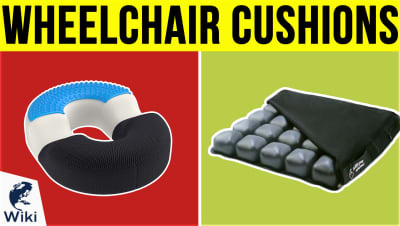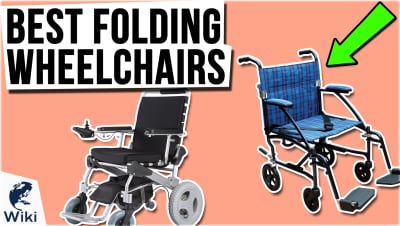The 10 Best Lightweight Wheelchairs

This wiki has been updated 40 times since it was first published in October of 2016. If you or a loved one are searching for a mobility solution that will enable you to get around comfortably, then one of these lightweight wheelchairs may be perfect for your needs. They can support most patients, while still being easy enough to fold up and carry or place in a vehicle. In addition to transport chairs and traditional user-propelled models, we have also found some powered options. When users buy our independently chosen editorial choices, we may earn commissions to help fund the Wiki.
Editor's Notes
October 30, 2020:
Lightweight wheelchairs offer a whole new level of portability over their traditional counterparts, since they are considerably easier to pick up and put into a trunk or anywhere else required. For our purposes, we considered anything less than 40 pounds to be lightweight for manual models, and anything less 60 pounds for electric options. We also made sure to take into account other features that provide for a better user experience, which can be anything from comfort to ease of rolling to braking capabilities.
Regarding electric models, we, unfortunately, had to remove the EZ Lite Cruiser, which we had previously recommended. As much as we liked the specs, such as the impressive 20-mile range when equipped with two batteries, the left- or right-side mountable joystick, and non-marring grey wheels, it simply turned out not to offer the longevity one should be able to expect from such an expensive purchase. And, perhaps just as importantly, it didn't seem to have one particular component that was prone to failure that the manufacturer could easily remedy. In its place came the Innuovo Intelligent Electric. While it doesn't offer nearly the same range, it is powerful enough to climb up reasonably steep slopes. Plus, its tight turning radius should allow for easy maneuverability in most situations.
We already had the Karman S-2512q on our list, and we are still impressed with the extremely low, 20-pound weight, but we decided to also add the Karman S-Ergo 305, which, as the name implies, offers better ergonomics than the S-2512q, though it is a bit heavier, coming in at 29 pounds. We think users will appreciate height-adjust armrests that can swing fully up and out of the way during transfers, as well as the thick cushion that can help prevent pressure sores. Of course, if the armrests fit your body's proportions well, you may be able to get an equally comfortable ride with the Karman S-2512q and the purchase of a wheelchair cushion.
Speaking of adjustability, the Drive Medical Cruiser X4 definitely stands out in this regard. Not only can you adjust the height of its armrests, but also the depth of the seat and the overall height of the chair. However, it does tip the scales at a hefty 39 pounds.
May 02, 2019:
Since wheelchairs are designed to make life easier, both for the rider and any family members or aides who help them, it makes sense that most people want a lightweight option that can be lifted into a vehicle without much hassle. After taking user needs into consideration, including price, comfort, and durability, we have settled on the best 10 models for most people. One thing that may surprise readers is to see a couple of powered options on our list, namely the Forcemech Voyager R2 and EZ Lite Cruiser. Well, considering they only weigh about 10 pounds more than some of the rider-propelled models, it was a no-brainer to include them. Of course, these powered wheelchairs command a premium price that may put them out of range for many consumers. Coming down in both price and weight, we have the Karman S-2512q, which, at 20 pounds, is the lightest rider-propelled option we could find, despite having all the features one could ask for. Unfortunately, this chair is also fairly expensive. For the people hampered by the tightest of budgets, we have included the Giantex SP34938 and Best Choice Foldable. While both of these models are respectable options, we recommend spending just a little but more if possible and going with the Invacare Tracer EX2, Drive Medical Cruiser III, or Drive Medical Rebel, all of which offer more features, such as elevating leg rests, adjustable-height armrests, or quick-release wheels, depending on which of these models you choose. If you or your loved one isn't capable of self-propulsion, a transport chair might be all you need, in which case you should look at the Drive Medical TR39E-SV or Nova 352R.
Special Honors
Featherweight 71061 At a mere 13.5 pounds, the Featherweight 71061 might just be the lightest user-propelled wheelchair around. It is available with either a grey or matte black frame, a one-inch colored seat overlay for an additional cost, and a variety of other accessories. 1800wheelchair.com
History Of The Wheelchair
It is not known exactly when the first wheelchair came to be, but the concept is believed to have been around since ancient times.
It is not known exactly when the first wheelchair came to be, but the concept is believed to have been around since ancient times. Archeologist found a stone slate in China that dates to somewhere between the 5th and 6th century B.C.E. that has inscriptions of wheeled furniture. There is also an image of a child's bed with wheels depicted in frieze on a Greek vase from the same time period. Three centuries later, the Chinese are known to have transported people using wheelbarrows, though they weren't specifically created for this purpose. Instead, they used the same wheelbarrows as were used for transporting heavy objects. Based on findings in Chinese art, it can be deduced that some time in the 6th century C.E., wheeled chairs purpose-built for transporting humans were created.
These early wheelchairs were not, however, intended solely for the transportation of disabled people. It is believed they may also have been used by the upper class as a means of effort-free travel. The first known wheelchair created for the disabled was invented in 1595. It was named the invalid's chair and was made for King Phillip II of Spain, who suffered from severe gout late in life. Just like the models of today, it featured a platform for his legs. Unlike models of today, it could not be self-propelled. It required the assistance of another person to push it.
The first self-propelled wheelchair was invented in 1655 by Stephen Farfler, a paraplegic watchmaker. It more closely resembled an adult tricycle than what we normally picture as a wheelchair. It had three large wheels, two in the rear and one in the front, and a hand-operated cranking system. In the latter half of the 18th century, the Bath chair was created by John Dawson. It was so named, not because it was intended to be used in a bathtub, but rather because it was created in the town of Bath, England. As with the Farfler wheelchair, it was a three-wheel model, though later on four-wheeled models were created that could be drawn by horses and donkeys.
Between 1865 and 1900 wheelchairs began to take on a form akin to what is found today. Large rear push wheels and small front casters replaced older designs. Models with hollow rubber wheels and metal rims started to appear, and the pushrim was added for easier self-propulsion.
Wheelchairs continued to evolve, with the first motorized model invented in London in 1916 — though it never became commercially viable — and the first lightweight, collapsible model in 1932. In 1953 George Klein created a motorized electric wheelchair that would go on to become the first mass produced version. It was manufactured and marketed by Everest & Jennings, a company that provided disabled veterans of World War II with free wheelchairs.
What To Consider When Choosing A Lightweight Wheelchair
It is important to take the needs and physical ability of the user into account when choosing a lightweight wheelchair. Those who have less upper body strength will require the lightest weight model possible. The same can be said for individuals who often self-propel for many miles at a time. These will usually be made from aluminum or titanium. Models are available in both materials that can weigh as little as 20 pounds.
The same can be said for individuals who often self-propel for many miles at a time.
If the wheelchair will be used in a nursing home or hospital, then it is important to take adjustability into account. The more adjustable the different components of a chair, like the seat and arm rest height, braces, and back support, the wider the range of individuals that can comfortably use it. Models intended for use in public facilities should also have a high weight capacity.
Comfort should also be a deciding factor when determining the best wheelchair for a user. Features like width and padding of the arm rest, material make-up, and seat cushioning can play a huge factor in how comfortable, or uncomfortable, a particular model is. Ideally, one should choose a model that has a breathable seat and back material. Padded calf rests can also greatly enhance comfort.
Next, one should determine if they need a foldable or rigid model. Rigid models will often feel more stable and sturdy, but they are also more difficult to transport. Some rigid models may have backrests that fold down to make transporting them slightly easier, but they will still require a large vehicle, like a van or SUV. Folding models are ideal for those who have a smaller vehicle, yet still want to be able to come and go as they please. Most folding models can collapse small enough to fit into a trunk or backseat, and can be stored away in a closet when not in use. The trade-off is that folding models may have smaller front wheels, feel slightly less stable, and not handle difficult terrain as well.
Benefits Of Lightweight Wheelchairs
No matter what type of model you choose, the benefits of lightweight wheelchairs are clear for both the user and aides. The less a wheelchair weighs, the easier it will be to push. This can result in significantly less fatigue when traveling for long distances. Since the main purpose of a wheelchair is to give the user more mobility, having a lightweight model greatly enhances the effectiveness of the chair's essential use.
Lightweight wheelchairs also tend to be more responsive. It is easier for users to adjust their path as needed or maneuver around obstacles as opposed to struggling with heavy models. This makes them ideal for active users who still like to play sports, despite their disability. For these types of users, titanium models are a good choice, as they still tend to feel very stable and offer better shock absorption than aluminum wheelchairs. In addition to increased maneuverability, lightweight models build up less momentum, allowing users to stop quickly in case of an emergency, making them safer.
As one might expect, lightweight models are easier to pick up. This makes carrying them up or down stairs or putting them into a car trunk less difficult and cumbersome. This can be a Godsend for an aide or family member who often has to carry the chair between different floors of a home or pack it into a vehicle for travel.


